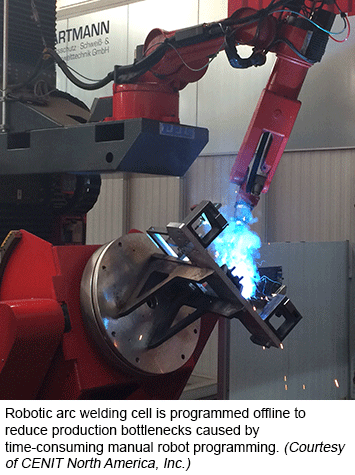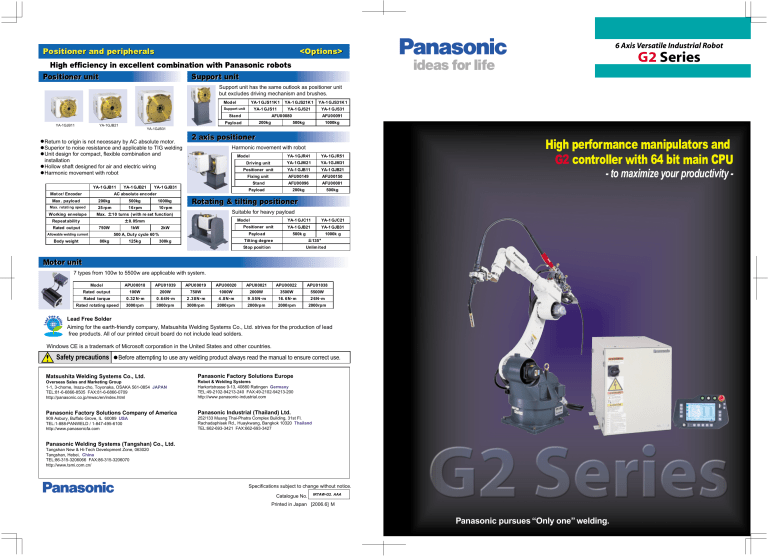CZ-RTC2 Installation Manual (752KB) CZ-RWSC1U Installation Manual (288KB) CZ-RTC5B Installation Manual. CZ-64ESMC1U System Controller Installation Manual (842KB) CZ-64ESMC2U System Controller Installation Manual. CZ-256ESMC1U Intelligent Controller Installation Operation Manual (7.14MB). Panasonic Robot & Welding offers turnkey, automated welding systems for arc and laser welding – with welding robots, welding power sources, welding torches etc., void of interface problems for various welding tasks in industrial production. Whether general industry or the automotive industry, we always offer the optimum solution based on user requirements for the product to be produced. Panasonic Industrial Robotics PANASONIC ROBOTIC PARTS & SERVICE IS WHAT WE DO. From finding parts for an older Panasonic robot (or Panarobo) to help with your Panasonic Performarc system, we know your Panasonic Industrial Robot from the inside and out. With over 10,000 Panasonic robotics and welder parts, many new on the shelf.
Description
2005 Panasonic TAWERS TA-1400WG
DEMO Robot; Never in Production
6kg High Performance Dedicated Arc Welding Robot with 1374mm reach
Article on Panasonic TAWERS Robots
– As printed in May 2005 Issue of ‘Canadian Industrial Machinery’
– Canada’s Metalworking & Fabricating Technology Magazine
TAWERS: A High Level of Intelligence for the Arc Welding Industry
The next generation of arc welding robotic systems has arrived. Having recently undergone a name change, the newly christened Panasonic Factory Solution Company is making a big splash later this month at the American Welding Society meeting in Dallas by using this forum to introduce TAWERS – The Arc WElding Robot Solution.
“When we decided to create TAWERS, we understood that we were, in fact, building the next generation of welding robot,” said Tim Nacey, group manager.
Introduced last summer in Japan, the North American debut will enable the company to once again assert itself as a specialist in the robotic arc welding business. Revolutionary in some aspects, this robotic system boasts a 64-bit computer control system that has integrated the robot controller and the power source controller onto a single, powerful board.
“Our mandate for this system was to take all we have learned from the robot side of our business and everything we know about welding and fuse them together into a product that no one can compete with,” explained Sean Walters, product manager, who was also a member of the design team.
By looking at competitive machines, Panasonic benchmarked where the industry would be going in the near future and that enabled their engineers to come up with solutions that could not be provided by other companies.
“No one else can supply a product like TAWERS,” boasted Walters.
Inside the Technology
After the deliberation of design meetings, what Panasonic found was that people believed that the robot was simply a motion device that added nothing to the welding process. This is what Panasonic set out to change, since they believed that their competitors in this market, were at heart, motion device manufacturers and did not have arc welding as one of their core processes.
“If you look at a standard arc welding robot’s mechanical setup there is a robot ‘brain’ and a welder ‘brain’,” explained Nacey. “We ended up saying that it was, in fact, possible to improve the communication and the functionality if we change how the robot and the power supply communicated. What we have done with TAWERS is put the CPU of the welder and teh CPU of the robot on the same card so now they can communicate together at bus speed rather than at the speed of the serial or even digital transmission. This is roughly 250 times faster than what it was before the coupling of these controllers.”
With a standard wire feeder and a standard power supply the robot sends a signal to power supply and the power supply sends a signal to the wire feeder. With TAWERS, the wire feeder control is also done on the same card.
“This ability to tightly integrate gives us a lot of functional improvement,” he added.

Arc Striking
One of the major problems that arises in the robotic arc welding business is flashbacks into the contact tip. You may be able to get four or five thousand arc strikes before the tip fuses or gets bent. One of the reasons that this happens, is that with a conventional robot and power supply, in order for an arc to be established there has to be a fusing of the wire to the plate.
Following this, the power supply has to send enough amperage to blast away that short circuit – causing a lot of spatter. And in so doing, the current surge, not only causes spatter but it also can degrade the contact tip due to microarcing and erosion of the tip due to the almost instantaneous surge in amperage well past what is normal.
The TAWERS robot and power supply is extremely different. In this new system the wire feeder comes down and touches the plate, but unlike the conventional method, the TAWERS system lifts the arc off of the plate, much like striking a match, so there is no high current surge. As the robot pulls up, the arc voltage increases, the base metal is heated but no spatter is created.
“At that point, since the robot, the wire feeded and the power supply are all integrated together, we can coordinate the key movements and power changes,” explained Nacey. “At this point the robot settles back down to the plate and a perfect weld is created.”
Nacey added that a substantial improvement in weld arc strike rates, now approaching a perfect 100 percent as opposed to the conventional systems, which are still in the 96 to 98 percent range, is seen.
“We are now expecting double the contact tip life because of these reasons,” he said. “That relates directly to the productivity since every time a contact tip needs to be replaced, not only is that robot down, but the entire line must be stopped until the change is made.”
The same integration that enables perfection at the arc starting stage also equates to the arc ending stage when the wire feeder must slow, voltage must lower and the robot moves.

Height Control
With a standard robot arc welding system there is no height control of the arc above the work. With the TAWERS system you can set an optional function and the tip will remain at a constant height above the material as the weld is being placed.
Arc Control
“As a result of this system’s computing power, we can do a lot of things, relative to arc control, that are absolutely impossible for our competitors to do,” said Nacey. “This has led us to develop a variant in standard welding process that we call SP MAG as an alternative to short circuiting (CV welding) performance.”
The TAWER’s system’s SP MAG welding creates spatter that would normally be associated with regular, pulse welding. This means that the customers can now buy the TAWERS robot arc welding system and use the SP MAG process where it’s appropriate on thinner materials, use pulse welding, which is more appropriate for thicker materials and also use low current CV operation.
“You almost have to see this system in operation to believe it,” said Nacey. “When I show this to customers, and when they see the SP MAG process running, they are in total disbelief in the lack of spatter that is produced.”
Eliminated spatter is one of the most significant aspects that this machine has really been able to contribute to the marketplace. It is something tangible that customers can get excited about.
In some high performance welding lines you can get a couple of hundred pounds of spatter coating the machine in a year.
When you start figuring the effects of that on the tooling, on the torch and on the parts, it becomes a real problem and a lot of money is spent every year fighting this build-up.
“When we use the term ‘The arc welding robot solution’, we mean it,” said Nacey. “What we have is a faster, more stable mechanical manipulator, computing systems that are now integrated together and a servo wire feeder that is combined in a single system.”
Specifications
Everyone's excited about finding great parts and service for their panasonic roboT.
Panasonic Welding Robot Manual
Panasonic Industrial Robotics
Panasonic Robot Manual Pdf
From finding parts for an older Panasonic robot (or Panarobo) to help with your Panasonic Performarc system, we know your Panasonic Industrial Robot from the inside and out. With over 10,000 Panasonic robotics and welder parts, many new on the shelf. We have a complete understanding of the Panasonic Robotics product line. INS Robotics is who the other companies come to for advice to get through a tough problem. We have the parts and knowledge to fix the hardest problems. Our company is relatively new, but many of our staff have been experts in Panasonic equipment for 2 decades.

Panasonic Robotic Welder

Panasonic Robot Manuals
- Robot PM's
- Applications Assistance
- Teach Pendant Repair
- Welder Repair
- Training Classes
- Tech Support
Panasonic Robot Tm 1400 Manual
- Over 10,000 Panasonic Parts
- Motors
- Main Cpu's
- Amps
- Tips, Liners, Torches, Feeders
- Teach Pendants